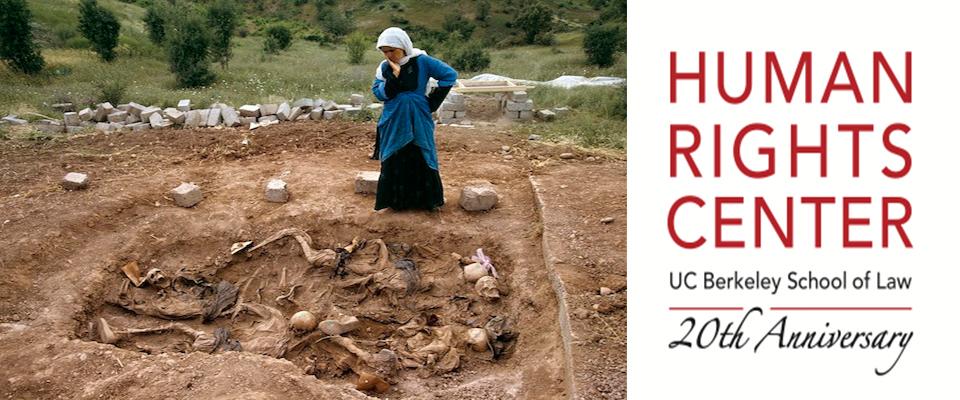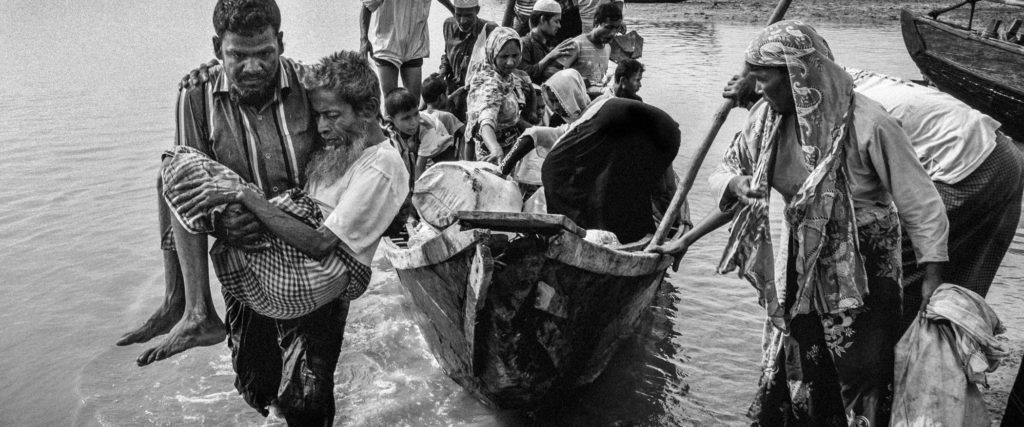The first thing likely to hit viewers of a new photo exhibit on the UC Berkeley campus—given that it features images from some of the most strife-torn places in the world—is the lack of any graphic violence.
“Envisioning Human Rights,” which opens Thursday at the UC Berkeley School of Law and includes the work of 10 photographers, purposely avoids shock and awe, says Eric Stover, faculty director of the Human Rights Center, which he founded two decades ago to document war crimes and their victims. His wife, artist Pamela Blotner, curated the exhibit to highlight the center’s work.
“In this image-saturated world, we wanted to take people back to where the photographers spent time capturing the dignity and resignation of humans under threat,” he says. “We want people to stop—and look.”
The photos, in color and black-and-white, span four decades and were shot in Angola, Guatemala, Brazil, Burma, Cambodia, Bosnia, Rwanda, Moldova, Iraq, Uganda and the Mississippi Delta in the United States. The 33 still images in the display evoke a sense of the complexity of conflict and political struggle.
“More than anything else, it is photography’s inherent ambivalence that appeals to me now,” writes Nic Dunlop, whose images include Burma under military rule and the impact of land mines in Cambodia. “A single image can contain a mass of contradictions. And it can be wonderfully subversive.”

Dunlop’s portrait of Aung San Suu Kyi, for example, may at first glance “celebrate her status as an icon of human and democratic rights,” Dunlop writes. “But for every positive attribute a less flattering one can also apply: She can be seen as courageous but arrogant, principled but self-righteous, determined but inflexible. The more one looks at an image, the more complex it becomes and conveys a truer reflection of a situation or personality.”
Mimi Chakarova, a Bulgarian-born journalist who came to the United States as a child, spent most of the past decade investigating the impact of sex trafficking on thousands of young women in Eastern Europe after the fall of Communism. The idea for the project hit her after she returned to her village for a visit and learned that many of the girls she had known had not been seen for a long time—and likely had been sold into the sex trade.
Her quest, she says, “was to find girls who had escaped” from sexual slavery. She found Vika, 22, in a women’s shelter in Moldova, one of the poorest areas of Europe. Vika had been approached by traffickers who promised her well-paying work as a waitress, but she ended up far away in Dubai in the United Arab Emirates, serving clients instead of tables. She was beaten and impregnated before escaping.
By word of mouth, Chakarova found other women who had been abused in similar ways to tell their stories, and the result was Chakarova’s award-winning documentary film, “The Price of Sex,” which premiered in 2011. Chakarova, who has taught at UC Berkeley’s Graduate School of Journalism for 14 years, said she last had contact with Vika five years after their initial contact at the shelter, and that Vika said she was planning to get married.
“I don’t know what happened to her,” Chakarova says. “I hope that she married and was not re-sold. But I don’t know.”

Stover, an adjunct professor of law and public health, has spent much of his adult life traveling to areas of conflict, often in the company of photographers whose work is on display at the law school. In 1999, at the height of the Kosovo war, he and photographer Gilles Peress spent weeks interviewing and photographing some of the thousands of refugees fleeing from Serbian soldiers and paramilitary forces. It was the largest expulsion of civilians in Europe since 1945.
A decade earlier, Stover, who was executive director of Physicians for Human Rights, joined photographer Susan Meiselas and the late forensic anthropologist Clyde Snow to document dozens of mass graves in an Iraqi region where Saddam Hussein waged a military campaign that resulted in the disappearance or deaths of thousands of Kurds.
“Working with a small group of Kurds, Meiselas writes, “we excavated where the gravediggers remembered burying the dead. Meticulously, earth was shoveled and then brushed away by hand, until finally the skull of a male teenager appeared, bearing a cloth blindfold.” Snow, who would later testify against Hussein, concluded that the boy was killed execution-style.
“I felt strange,” Meiselas adds, “photographing this and other similar scenes while understanding so little about the past. Now I realize that the unearthing of these graves was what brought me back repeatedly to northern Iraq, to further digging, and to the publication of my book Kurdistan: In the Shadow of History.”
Ken Light, a photojournalism professor at Berkeley, traveled to the Deep South 25 years ago to document the living conditions of people in perhaps the most impoverished area of the United States—the rural Mississippi Delta. And like Meiselas, he returned to see what changed.
In his 1989 assignment, Light photographed an abandoned plantation shack, framed in the stark landscape and still standing, seemingly held up in part by brambles. To him, the shack symbolized the generations of economic decline after the Great Depression, when the mechanization of cotton growing “tossed 100,000 people off the land,” he says. Most of the sharecroppers sought work in cities.
Little had changed, Light found on his recent visit. If anything, he says, there are signs of more poverty. “Conditions have absolutely not improved and may be worse in many of the towns—they are more abandoned than before. They are like ghost towns.”
What might be the impact of the Berkeley exhibit? Stover says he hopes it will inspire action and that the Human Rights Center will be a catalyst. “Our focus is on vulnerable people and the way we can make systems work for them.”

Photographer Peress poses a dilemma:
“I keep asking myself this fundamental question,” he writes. “Can human rights photography, like 18th-Century novels, be a vehicle for empathy? Can photographs motivate viewers to engage with human rights issues and bring about real change? Badly used photography can be a vehicle for propaganda or emotional exploitation of the worst kind and, ultimately, desensitize viewers.”
But if people accept the more cynical argument, he adds, “We run the risk of photographs not being taken and entering a black hole where we neither see nor act. Which do you choose?”
“Envisioning Human Rights” opens Thursday with a 5 p.m. reception in the Steinhart Courtyard of UC Berkeley’s School of Law. The photographs will be available for sale at the reception, and a silent auction of the photos opens Oct. 13. Proceeds will benefit the work of the Human Rights Center.




















